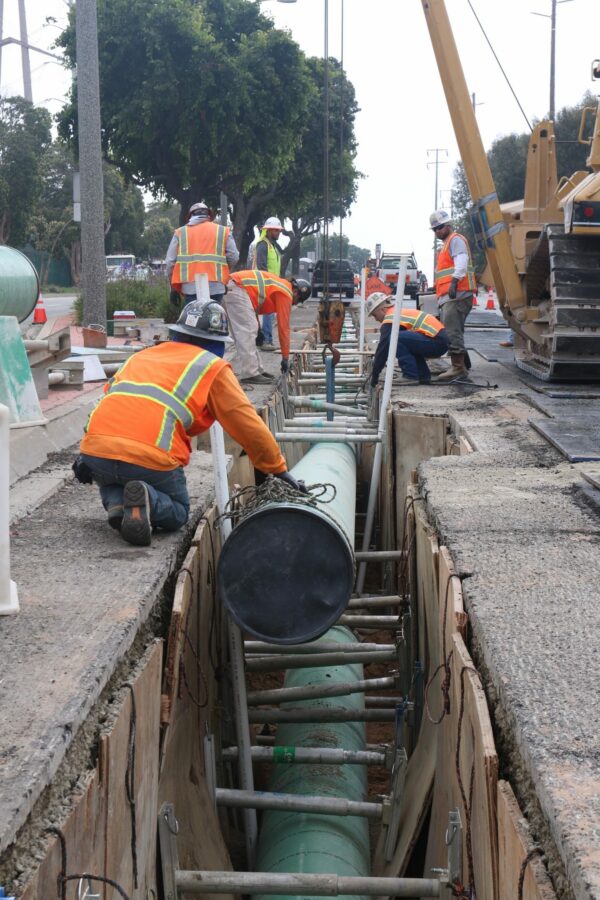SoCalGas line project disrupts North Manhattan Beach

A Southern California Gas Company crew drops a new 20-inch pipe on Rosecrans Avenue Tuesday morning. Photo
Jeremy Gonzalez lives right off Highland Avenue in North Manhattan Beach and works the graveyard shift just down the street at the Scattergood power plant in El Segundo. In February, he saw crews from the Southern California Gas Company begin work a few blocks away from his home, digging trenches, creeping a little closer in his direction daily.
One day he came home at 2 p.m. after a 16 hour shift and realized the onslaught had arrived. Just feet from where he was trying to sleep, the clanking began. Another morning he was home by 4 a.m., but two hours into sleep, a construction crew removed the pylons that kept traffic from the large metal plates covering a pipeline trench. To Gonzalez, it felt like bombs dropping. His entire house shook.
He repeatedly called the Gas Company. Once, at 6 a.m., he even called the police. But there was nothing that could be done. He spent most of the next month couchsurfing with friends and staying with his girlfriend.
“I just had to leave,” Gonzalez said. “I don’t have a decibel monitor but it was loud. I mean, I heard a story that one guy down the street had his window shattered by the noise.”
Gas Company officials knew that this project, called the El Segundo Loop Project, would be disruptive. What is unusual about it is that it’s not a maintenance project but rather the installation of 2.8 miles of brand new 20-inch pipes in three different cities — from Aviation Boulevard in Hawthorne, all the way up Rosecrans Avenue in Manhattan Beach, and north along Highland Avenue up to the NRG plant just across the city border in El Segundo.
SoCalGas Project manager Kevin Morisset remembers more three years back scouting for any other way to do this project other than utilizing Rosecrans, one of the busier streets in the South Bay.
“We looked everywhere. We kind of knew all along, but after we’d looked at all the alternatives, we thought, ‘Oh no, it’s Rosecrans,’” Morisset recalled, noting that an independent study commissioned by SoCalGas arrived at the same conclusion.
SoCalGas public affairs manager Faviola Ochoa said that five to seven other routes were considered, and subsequently ruled out.
“All the other alternatives were to run [the pipeline] down residential areas,” Ochoa said.
“We look at everything. We look at what is going to cause the most impacts in a community. We knew Rosecrans was obviously a very busy street, but it’s technically not as narrow as a residential street. This would impact less residents than the other routes.”
The underlying reasons for the project are to improve the safety and reliability of the gas transmission line system. It’s called the El Segundo Loop Project because it’s intended to create redundancy with another major gas line that runs along El Segundo Boulevard and eventually terminates at NRG by way of Grand Avenue. By both state and federal regulations, all gas lines must be inspected, at a minimum, every seven years. Without redundancy, gas service is interrupted in the area in which testing occurs. So the project, despite the disruptions it is presently causing, ultimately is intended to cause less disruption to service overall.
A second line on El Segundo Boulevard was not an option.
“For safety reasons, we can’t have two pipelines next to each other,” Ochoa said. “If something happens to one, because they are so close, you are going to have a problem….It’s redundancy for reliability.”
The public outreach effort regarding the project started two years ago and included neighborhood informational meetings — which were barely attended — a presentation at City Council and notices in the mail. Even so, the neighborhood seemed to be caught off guard. The complaints, Ochoa said, have been voluminous.
“As far as neighbors, it’s like everything — you don’t necessarily pay attention until it comes up and, you know, a lane is shut down on Rosecrans, or it’s waking you up at night. We get that,” said Melissa Bailey, a SoCalGas spokesperson who also happens to live in the neighborhood. “We are all the same way. But people don’t usually focus on the benefits, which is the safety of our pipeline, and the reason we need to do this, which is because of additional usage [in the area].”
Ochoa responds to concerns 24 hours a day. Her phone number is the hotline for complaints, which she says she gladly fields. Recognizing from the outset that this project would cause disturbances, she said, the intention of the Gas Company was to always be available to respond to complaints and mitigate problems as much as possible.
“If you are calling us at three in the morning, you want us to know,” she said. “So I am glad to answer your calls.”
The noise from the metal plates has caused the most disruption. The Gas Company closes the lanes on which the plates rest from 9 p.m. to 5:30 a.m. every day. Workers have also put carpets under the plates in an attempt to reduce vibrations. Lanes are also periodically closed when pipes are being hauled in and installed.
Morisset noted that the Gas Company has three crews working on the $25 million project, including one that works all night east of Pacific Coast Highway on Rosecrans in order to minimize morning commuter disruption. The portion of the project on Highland will be completed this week, in line with a moratorium in place in Manhattan Beach preventing construction in that business corridor after Memorial Day. The rest of the project is scheduled for completion by mid-July.


